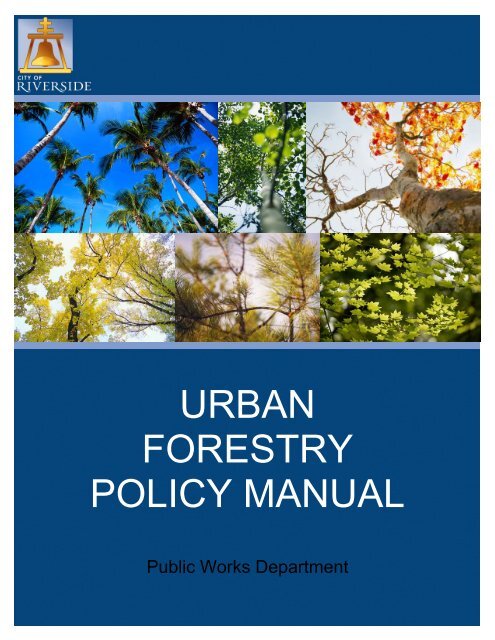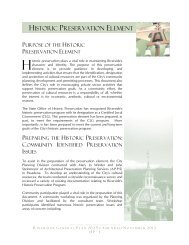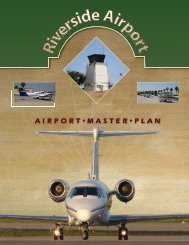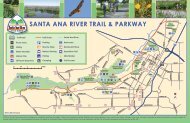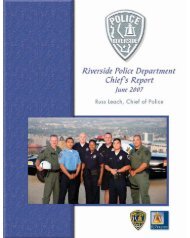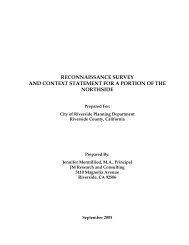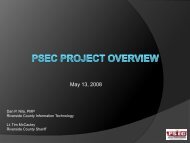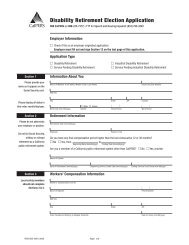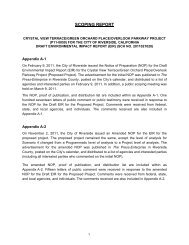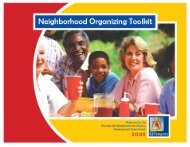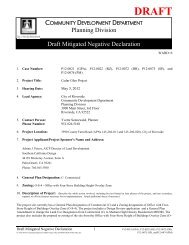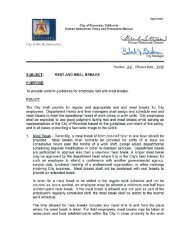Urban Forestry Policy Manual - City of Riverside
Urban Forestry Policy Manual - City of Riverside
Urban Forestry Policy Manual - City of Riverside
You also want an ePaper? Increase the reach of your titles
YUMPU automatically turns print PDFs into web optimized ePapers that Google loves.
URBAN<br />
FORESTRY<br />
POLICY MANUAL<br />
Public Works Department
Revised November 2007<br />
3
TABLE OF CONTENTS<br />
INTRODUCTION 5<br />
WHO CARES FOR THE URBAN AND COMMUNITY FOREST? 6<br />
FUNDING FOR THE URBAN AND COMMUNITY FOREST 8<br />
TREE CARE GUIDELINES 9<br />
TREE PRUNING GUIDELINES 10<br />
Need for Pruning 10<br />
Property Owners Ability to Prune Trees 10<br />
Tree Pruning Specifications 10<br />
Safety Pruning Specifications 13<br />
TREE PRESERVATION GUIDELINES 14<br />
TREE REMOVAL GUIDELINES 17<br />
STREET TREE ASSET VALUE 22<br />
MASTER URBAN FOREST PLAN GUIDELINES 23<br />
TREE PLANTING GUIDELINES 25<br />
PLANTING SPECIFICATIONS 27<br />
TREE/HARDSCAPE CONFLICTS GUIDELINES 30<br />
TREE/UTILITY CONFLICTS GUIDELINES 31<br />
Sewer Lines 31<br />
Water Lines 31<br />
4
Introduction<br />
The <strong>City</strong> <strong>of</strong> <strong>Riverside</strong> is known as a “<strong>City</strong> <strong>of</strong> Trees.” Trees beautify the landscape<br />
and enhance the quality <strong>of</strong> life for all residents. Since 1987, The National Arbor<br />
Day Foundation has recognized our <strong>City</strong> as a “Tree <strong>City</strong>, USA” in honor <strong>of</strong> the<br />
care we provide for our trees. The purpose <strong>of</strong> the <strong>Urban</strong> <strong>Forestry</strong> <strong>Policy</strong> <strong>Manual</strong><br />
(“<strong>Manual</strong>”) is to provide guidelines for the preservation and protection <strong>of</strong> our tree<br />
heritage and the <strong>Urban</strong> Forest <strong>of</strong> <strong>Riverside</strong>. This <strong>Urban</strong> <strong>Forestry</strong> <strong>Policy</strong> <strong>Manual</strong><br />
supersedes the 2005 <strong>Urban</strong> <strong>Forestry</strong> <strong>Policy</strong>.<br />
The following pages document guidelines for the planting, pruning, preservation<br />
and removal <strong>of</strong> all trees in city right-<strong>of</strong>-ways and recreational facilities. These<br />
specifications are based on national standards for tree care established by the<br />
International Society <strong>of</strong> Arboriculture (ISA), the National Arborists Association<br />
and the American National Standards Institute. This <strong>Manual</strong> incorporates input<br />
from Public Works Department staff, the Parks, Recreation and Community<br />
Services Commission, <strong>City</strong> Council, various other commissions and the citizens<br />
<strong>of</strong> <strong>Riverside</strong>.<br />
This <strong>Manual</strong> is a reference for use by <strong>City</strong> staff, private contractors, volunteer<br />
organizations and citizens when working in and around trees within <strong>City</strong><br />
jurisdiction.<br />
5
Who Cares for the <strong>Urban</strong> and Community Forest?<br />
The 100,700 street trees and 40,000 park and open space trees throughout<br />
<strong>Riverside</strong> are a community asset valued at more than $332,661,560. The urban<br />
forest provides environmental benefits, adds to property value and provides an<br />
enhanced quality <strong>of</strong> life for all residents.<br />
Unfortunately, <strong>Riverside</strong>’s trees suffer from the rigors <strong>of</strong> urban life such as air<br />
pollution, limited water, vandalism, compacted soils, limited growing spaces, and<br />
the extremes <strong>of</strong> our Southern California climate. In order to reap the benefits <strong>of</strong><br />
this valuable asset, the care <strong>of</strong> <strong>Riverside</strong>’s <strong>Urban</strong> Forest must be a public/private<br />
partnership.<br />
The <strong>City</strong> Council<br />
Elected <strong>of</strong>ficials who provide leadership, at the request <strong>of</strong> citizens, ensure that<br />
trees are a priority in our community. The <strong>City</strong> Council oversees the General<br />
Fund, which supports the planting and care <strong>of</strong> the urban forest. They also make<br />
decisions regarding policies and ordinances, which pertain to the care and<br />
protection <strong>of</strong> trees on public property and the development <strong>of</strong> private property as<br />
it pertains to our <strong>Urban</strong> Forest.<br />
Parks, Recreation and Community Services Commission<br />
Appointed by the <strong>City</strong> Council, this nine-member Commission oversees the<br />
<strong>Urban</strong> and Community <strong>Forestry</strong> Program. The Commission has the power and<br />
duty to “Establish policies . . . for the planting, care and removal <strong>of</strong> trees in parks<br />
and on streets, subject to the rights and powers <strong>of</strong> the city council.”<br />
<strong>Urban</strong> and Community Forest Subcommittee<br />
Annually appointed by the Parks, Recreation and Community Services<br />
Commission Chairperson, the <strong>Urban</strong> and Community Forest Subcommittee,<br />
together with Public Work staff, discusses issues and visits sites to make<br />
recommendations to the Parks, Recreation and Community Services<br />
Commission on tree issues in public landscapes.<br />
This Subcommittee shall review the <strong>Urban</strong> <strong>Forestry</strong> <strong>Policy</strong> <strong>Manual</strong> a minimum <strong>of</strong><br />
every two years.<br />
Public Works Department<br />
The Department, under the guidance <strong>of</strong> the Public Works Director, employs an<br />
experienced <strong>Urban</strong> Forester who specializes in the management <strong>of</strong> urban and<br />
community forests and provides the daily management and emergency services<br />
6
which sustain our urban forest. The Public Works Department provides planting<br />
and maintenance services and also oversees contracted and permitted tree work<br />
on city trees.<br />
7
Funding for the <strong>Urban</strong> and Community Forest<br />
The primary source for funding is the General Fund. In an effort to augment<br />
limited city resources available for urban forestry, additional funding sources are<br />
<strong>of</strong>ten sought. Alternatives include a “Perpetual Tree Care Fund,” public grants,<br />
private donations, and the use <strong>of</strong> volunteer labor for tree plantings.<br />
<strong>Riverside</strong>’s Perpetual Tree Care Fund<br />
This fund is separate from the General Fund. It is managed through the <strong>Riverside</strong><br />
Chamber <strong>of</strong> Commerce solely for the enhancement <strong>of</strong> the community forestry<br />
program. Sources <strong>of</strong> revenue for the fund include contributions directly to the<br />
fund and other private donations. Tax-deductible contributions may be made to<br />
the <strong>Riverside</strong> Perpetual Tree Care Fund c/o the Greater <strong>Riverside</strong> Chambers <strong>of</strong><br />
Commerce, 3985 University Avenue, <strong>Riverside</strong>, CA 92501.<br />
Adopt-A-Park Program<br />
This program enables community groups to sponsor park cleanups. Groups may<br />
select a specific park and specific amenities within that park for which to care (i.e.<br />
ball fields, lakeshore, playgrounds, etc.)<br />
Grants<br />
The staff <strong>of</strong> the Public Works Department actively researches the availability <strong>of</strong><br />
grants for community forestry programs. Monies from these grants help to<br />
augment and sustain the urban forest.<br />
8
Tree Care Guidelines<br />
The care and maintenance <strong>of</strong> <strong>City</strong> trees is both an investment and a very<br />
valuable resource. Trees in an urban environment are subject to many variables<br />
that affect their health: air pollution reduces a tree’s ability to make food;<br />
compacted soils from road and structure development interfere with the uptake <strong>of</strong><br />
nutrients and water; and sidewalks, curbs, streets and buildings limit the space<br />
for trees to spread their roots and branches. Tree care, such as deep watering,<br />
proper pruning and pest control help a tree maintain its health and stability.<br />
The guidelines in this <strong>Manual</strong> were developed to help reduce the many negative<br />
impacts on <strong>City</strong> trees and to provide for effective management <strong>of</strong> the urban<br />
forest. Following the tree pruning, tree planting and other guidelines in this<br />
<strong>Manual</strong> will result in an increase in the value <strong>of</strong> our trees and a reduction in the<br />
costs to maintain them.<br />
Cultural Practices<br />
Practices such as deep watering, prevention <strong>of</strong> damage to bark from string<br />
trimmers and mowers, the use <strong>of</strong> mulch or wood chips and proper pruning and<br />
staking, provide preventative care for trees. These practices help keep a tree<br />
healthy so it can maintain its own natural defense system.<br />
Pest Control<br />
Proper planting, pruning and care <strong>of</strong> trees are the best ways to prevent pest<br />
problems. A tree has a natural ability to withstand a certain amount <strong>of</strong> insects<br />
and disease. When a tree suffers from other impacts which deplete its foodmaking<br />
capability (photosynthesis) and uptake <strong>of</strong> water and nutrients, its natural<br />
defenses are weakened.<br />
When insect and/or disease infestations become a detriment to the tree, controls<br />
are used. When pest control is recommended, natural or biological substances<br />
are considered first, with chemical pesticides used only when warranted.<br />
Pest control is based on the timing and intensity <strong>of</strong> the infestation. Inspections <strong>of</strong><br />
trees are made based on the time <strong>of</strong> year and weather conditions that have<br />
favored the development <strong>of</strong> insect problems in past years. Not all problems are<br />
predictable and may not be treatable. If there are requests by residents, an<br />
inspection is conducted and recommendations are made based on the timing<br />
and effectiveness <strong>of</strong> the control.<br />
9
Tree Pruning Guidelines<br />
Need for Pruning<br />
Trees are pruned principally to preserve their health and appearance and to<br />
prevent damage to property and human life. Broken, dead, or diseased branches<br />
are pruned to prevent decay from spreading. Live branches are removed to<br />
permit penetration <strong>of</strong> sunlight and air circulation which helps maintain a strong<br />
and healthy tree.<br />
All public trees should be completely pruned on a periodic basis based on the<br />
needs <strong>of</strong> the species. Frequency depends on funding levels.<br />
Additional tree pruning is done on an “as needed” basis. Specific examples<br />
where as needed work is authorized are:<br />
1. Pruning tree limbs that interfere with city utility lines.<br />
2. Pruning tree limbs that interfere with street light illumination and are<br />
not scheduled for periodic pruning within two (2) years.<br />
3. Pruning tree limbs that interfere with buildings or other private or public<br />
facilities.<br />
4. Pruning hazardous limbs, such as large dead limbs greater than two<br />
(2) inches in diameter, hangers and structurally unsound limbs.<br />
5. Pruning tree limbs that interfere with safe vehicular or pedestrian<br />
traffic.<br />
6. Sucker pruning.<br />
Property Owners Ability to Prune Trees<br />
There are two options available to property owners who would like to have public<br />
tree(s) pruned more frequently than the scheduled trim cycle. First, a resident<br />
may pay a designated fee (see attached) to the <strong>City</strong> to have a tree trimmed<br />
outside the normal grid trim cycle. The <strong>City</strong>’s contractor will prune the tree within<br />
30 days <strong>of</strong> the request. Second, a resident may apply for a permit and hire a<br />
licensed and insured contractor to trim the tree(s) according to city standards. A<br />
property owner may raise mature trees to eight (8) feet for clearance without a<br />
permit.<br />
Tree Pruning Specifications<br />
10
Any tree work performed on a city tree must be completed according to the <strong>City</strong>’s<br />
specifications. There are different criteria for pruning depending on the purpose<br />
for the pruning.<br />
“Complete pruning specifications” are used when the entire tree needs to be fully<br />
pruned.<br />
“Safety pruning specifications” require less pruning and are used when specific,<br />
possibly hazardous (dead/dying) limbs need removal to eliminate all safety<br />
concerns. Safety pruning may be recommended in some circumstances instead<br />
<strong>of</strong> complete pruning. Safety pruning specifications are used for “as needed”<br />
pruning and address only safety concerns. Safety pruning includes only the<br />
basic requirements to address the problem.<br />
Where overhead wires pass through trees, safety and reliability <strong>of</strong> service<br />
demand that tree trimming be done to clear wires <strong>of</strong> branches and foliage. The<br />
minimum clearance must be followed as established by the California Public<br />
Utilities Commission General Order No. 95.<br />
All specifications are based on International Society <strong>of</strong> Arboriculture, National<br />
Arborist Association and American National Standards Institute criteria. This<br />
guarantees that <strong>Riverside</strong>’s city trees receive the best possible care.<br />
The following trimming specifications are for the use <strong>of</strong> any permitted pruning <strong>of</strong><br />
city trees.<br />
Method <strong>of</strong> Operation<br />
a. Trim trees to lighten and balance the trees, according to current<br />
International Society <strong>of</strong> Arboriculture Western Chapter standards.<br />
b. Remove dead wood and cross branches.<br />
c. Remove suckers. 1<br />
d. Remove diseased branches.<br />
e. Encourage radial distribution <strong>of</strong> all branches to provide a sufficient number<br />
<strong>of</strong> scaffold branches to fill the circular spaces as concentrically as possible<br />
around the trunk.<br />
f. Final trimming cuts shall be made without leaving a stub. Cuts shall be<br />
made just outside the shoulder ring area. Extreme flush cuts, which<br />
produce large wounds and weaken the tree at the cut, shall not be made.<br />
1 Vigorous, upright growth arising primarily from below the graft union or the ground from trunks or the<br />
roots.<br />
11
g. Trimming shall provide adequate clearance for any obstructed street sign,<br />
streetlight or other approved standard.<br />
h. Over sidewalks, limbs shall be raised a minimum <strong>of</strong> nine (9) and a<br />
maximum <strong>of</strong> twelve (12) feet from grade to wood. Where sidewalks do not<br />
occur or are located on the street side <strong>of</strong> a parkway, limbs may be<br />
retained below the minimum elevation, providing they conform to the<br />
natural shape <strong>of</strong> the species.<br />
i. Over residential streets, limbs shall be raised gradually from 12 feet curb<br />
to 16 feet over traffic lanes from grade to wood giving the appearance <strong>of</strong><br />
an arch rather than an angle. Near driveways where automated refuse<br />
containers are placed, it is imperative to have 15 feet <strong>of</strong> clearance.<br />
j. Over arterial streets, limbs should be raised a minimum <strong>of</strong> 14 feet and a<br />
maximum <strong>of</strong> 16 feet from grade to wood. A major arterial street may<br />
require a higher maximum over central traffic lanes for existing, mature,<br />
canopy-forming limbs.<br />
k. Whether over sidewalk or street, where the lowest limb is attached to a<br />
trunk above the desired elevation but extends below that elevation, it shall<br />
be cut back to a large lateral near the desired elevation, if possible, rather<br />
than removed altogether, in order to avoid giving the trunk a skinned<br />
appearance.<br />
l. Trimming shall not exceed the amount necessary to achieve the specified<br />
elevation at the time <strong>of</strong> raising and to compensate for tree species and<br />
trim cycle. No limb over three inches in diameter will be removed without<br />
prior <strong>City</strong> approval.<br />
m. No lion-tailing. An effect known as "lion-tailing" results from pruning out<br />
the inside lateral branches. Lion-tailing, by removing all the inner foliage,<br />
displaces the weight to the ends <strong>of</strong> the branches and may result in<br />
sunburned branches, water sprouts, weakened branch structure and limb<br />
breakage.<br />
n. Topping, stump cutting, hat racking, pollarding etc. is not acceptable.<br />
General Requirements<br />
a. Certified Tree Workers – All persons performing tree work on city trees<br />
should be trained according to tree care standards accepted by the<br />
International Society <strong>of</strong> Arboriculture, Western Chapter.<br />
12
. Certified to Work Around Electric Lines – All persons performing tree<br />
work on city trees in or around primary electrical lines must be trained to<br />
do so according to the “Electrical Safety Orders” <strong>of</strong> the State <strong>of</strong> California,<br />
including all amendments and revisions.<br />
c. Certified Arborist – Any city contracted tree company shall employ a fulltime,<br />
permanent certified arborist, as accredited by the International<br />
Society <strong>of</strong> Arboriculture. This person is responsible for ensuring that the<br />
contractor’s crew is performing work according to the <strong>City</strong>’s specifications.<br />
It is also recommended that <strong>Riverside</strong> residents use a firm that employs a<br />
certified arborist for any tree work.<br />
d. Contractor Qualifications – All contractors are required to have a state<br />
contractor’s license for tree work (C-61). Contractors are required to<br />
adhere to the specifications provided in the bid documents.<br />
Safety Pruning Specifications<br />
a. Proper disposal <strong>of</strong> all tree debris generated.<br />
b. Adhere to proper traffic control standards as adopted by the American<br />
Public Works Association, latest adopted version.<br />
c. Assure adequate safety <strong>of</strong> employees and the public in accordance with<br />
CalOSHA and Senate Bill 198<br />
.<br />
Safety tree pruning shall consist <strong>of</strong> the total removal <strong>of</strong> those dead or living<br />
branches as may menace the future health, strength and attractiveness <strong>of</strong> trees.<br />
Specifically, trees shall be pruned according to the Tree Pruning Specifications<br />
as outlined on pages 7, 8 & 9.<br />
13
Tree Preservation Guidelines<br />
Trees are an essential element <strong>of</strong> <strong>Riverside</strong>’s image and quality <strong>of</strong> life.<br />
Hardscape elements, such as sidewalks, curbs, gutters and driveways, are also<br />
indicative <strong>of</strong> the <strong>City</strong>’s commitment to maintain its infrastructure. Over the years,<br />
broken and damaged sidewalks, curbs, gutters and driveways will have to be<br />
replaced throughout the <strong>City</strong>. As a result, many trees will be involved. Whenever<br />
possible curbs, gutters and sidewalks should be meandered away from the tree<br />
thereby providing more growing space for roots. To manage this process and<br />
protect existing trees, the following departmental guidelines have been<br />
established:<br />
1. Root Pruning<br />
a. Whenever sidewalk, curb, gutter or driveway replacement occurs<br />
within four (4) feet <strong>of</strong> a tree, the Public Works <strong>Urban</strong> <strong>Forestry</strong><br />
Department will inspect the site for tree impact assessment. Root<br />
pruning may be performed on any tree that the Public Works<br />
Department determines can be safely performed without<br />
jeopardizing the life <strong>of</strong> the tree.<br />
b. All roots greater than two (2) inches in diameter must be cleanly cut<br />
to encourage good callus tissue. It is recommended that roots be<br />
pruned back to the next root node.<br />
2. Sidewalk Renovation - Trees that would be seriously impacted by root<br />
pruning during sidewalk replacements will be inspected by the <strong>Urban</strong><br />
Forester in coordination with the Street Division to determine whether:<br />
a. The repair work can be deferred and a temporary patch used to<br />
eliminate any hazard until other steps can be reviewed and<br />
implemented.<br />
b. The tree can be saved by narrowing the sidewalk near the tree,<br />
while still leaving sufficient sidewalk width for disabled access.<br />
Standard disability access width is four (4) feet.<br />
c. The tree can be saved by relocating the sidewalk onto private<br />
property and negotiating the appropriate easement.<br />
d. The tree can be saved by replacing the sidewalk with minimal<br />
disruption <strong>of</strong> the roots (alternatives: a temporary sidewalk,<br />
rubberized sidewalk, use <strong>of</strong> root barrier fabric, raising the sidewalk<br />
grade over the roots, an informal walkway, etc.).<br />
14
e. To remove the tree and replace it with a minimum 15 gallon<br />
replacement tree.<br />
3. Curb and Gutter Replacement - Trees that would be seriously impacted by<br />
root pruning during curb/gutter replacement will be inspected by the urban<br />
forester in coordination with the Street Division to determine whether:<br />
a. Where six or more trees along one side <strong>of</strong> a block are severely<br />
affected, consideration is to be given to relocating the curb and<br />
gutter into the street along the entire block.<br />
b. The tree can be saved by replacing the curb and gutter with<br />
minimal disruption <strong>of</strong> the roots (alternatives: temporary curb and<br />
gutter; use <strong>of</strong> root barrier fabric; rubberized panels, or by other<br />
methods).<br />
4. Recovery Period<br />
a. When significant root pruning on two sides <strong>of</strong> a tree is required,<br />
there will be a 24-month separation between sidewalk and<br />
curb/gutter repair to allow time for tree roots to recover. Work shall<br />
be authorized by the <strong>Urban</strong> Forester.<br />
b. An exception to this policy may be made if the curb/gutter or<br />
sidewalk is relocated away from the tree, or other measures are<br />
employed that reduce or eliminate root involvement or it is<br />
otherwise determined by the <strong>Urban</strong> <strong>Forestry</strong> Section that root<br />
involvement is minimal.<br />
5. Construction Projects on <strong>City</strong> Property - The following guidelines have<br />
been developed to protect trees on <strong>City</strong> property during construction<br />
projects:<br />
a. A root protection zone shall be defined by a minimum 42" high<br />
barrier constructed around any potentially impacted tree. This<br />
barrier shall be at the drip line or at a distance from the trunk equal<br />
to 6 inches for each inch <strong>of</strong> trunk diameter 4.5 feet above the<br />
ground if this method defines a larger area.<br />
b. Should it be necessary to install irrigation lines within this area, the<br />
line shall be located by boring, or an alternate location for the<br />
trench is to be established. The minimum clearance between an<br />
open trench and a street tree shall be one (1) foot, or six (6) inches<br />
for each inch <strong>of</strong> trunk diameter measured at 4.5 feet above existing<br />
grade if this method defines a larger distance. The maximum<br />
15
clearance shall be ten (10) feet. The contractor shall conform to<br />
these provisions unless otherwise directed by the <strong>City</strong>.<br />
c. At no time shall any equipment, materials, supplies or fill be allowed<br />
within the prescribed root protection zone unless otherwise directed<br />
by the <strong>City</strong>. The root protection zone is defined as the larger <strong>of</strong> the<br />
drip line <strong>of</strong> 1) the tree or 2) the distance from the trunk equal to six<br />
(6) inches for each inch <strong>of</strong> trunk diameter measured at 4.5 feet<br />
above existing grade.<br />
d. It is recognized that failure to abide by these provisions will result in<br />
substantial root damage to trees that may not be immediately<br />
apparent. The <strong>City</strong> will therefore assess damages according to the<br />
International Society <strong>of</strong> Arboriculture standards and bill the<br />
responsible party.<br />
6. Release Requirements<br />
a. In order for construction work that will impact a tree to begin, a<br />
signed release form must be issued by the Public Works<br />
Department. This release shall be based on the condition <strong>of</strong> the<br />
tree and an assessment <strong>of</strong> the impact <strong>of</strong> the proposed construction.<br />
Mitigation measures necessary to protect the tree will also be<br />
stated.<br />
b. In the event a tree must be removed, the Public Works Department<br />
will issue a Tree Removal Permit.<br />
7. Protecting Tree Roots From Vehicular Compaction<br />
a. In order to protect our <strong>Urban</strong> Forest and this <strong>City</strong> asset, it shall be<br />
unlawful for any vehicle to be parked in the public right <strong>of</strong> way,<br />
under the drip line <strong>of</strong> a <strong>City</strong> tree in non-paved areas such as<br />
parkway strips.<br />
16
Tree Removal Guidelines<br />
The Public Works Department is responsible for the maintenance <strong>of</strong> the street<br />
tree system. Individual trees can affect the environment <strong>of</strong> the total community.<br />
The Public Works Director or the Director’s designee shall have the authority to<br />
remove any hazardous, diseased or declining trees, providing that the removal<br />
meets the existing criteria as stated in the policy.<br />
The Director or Designee shall authorize all tree removals, with written Parks<br />
Recreation and Community Services Commission approval and with the authority<br />
granted in this policy.<br />
The Director shall provide the <strong>City</strong> Council and the Parks, Recreation and<br />
Community Services Commission with a monthly listing <strong>of</strong> the tree removal<br />
requests, including those from all <strong>City</strong> Departments, all citizens and all other<br />
sources, for Commission action. The list shall include the locations <strong>of</strong> the trees<br />
and the staff’s recommendations.<br />
Hazard Tree Removal<br />
Hazard tree inspections and the ISA Hazard Tree Evaluation Form shall be<br />
completed, including photo documentation <strong>of</strong> the condition <strong>of</strong> the tree(s).<br />
A hazard tree that is one that is dying, dead or structurally weak; a traffic<br />
obstruction; or injurious to the health, safety, or welfare <strong>of</strong> the general public.<br />
When a tree is determined by authorized staff to be a hazard, the tree will be<br />
removed and a replacement tree will be planted at the next appropriate planting<br />
cycle, unless inadequate parkway space exists or the location constitutes a<br />
hazard. Where long-term repairs can be made to sewer laterals, sidewalk or curb<br />
and gutter without endangering the stability <strong>of</strong> the tree, the tree will not be<br />
removed.<br />
“Inappropriate” Tree Removal<br />
An inappropriate tree possesses undesirable characteristics significant enough to<br />
have caused their elimination from future planting <strong>of</strong> street trees, as determined<br />
by the Parks, Recreation and Community Services Commission. Undesirable<br />
tree species shall be identified, approved by the Commission, and published.<br />
There are three (3) types <strong>of</strong> inappropriate trees:<br />
1. Class I Inappropriate - Tree species that cause chronic damage to<br />
infrastructure (i.e. curbs, gutters, sidewalks or other structures and trees)<br />
17
which, in the opinion <strong>of</strong> the Commission, are causing a nuisance to the<br />
property owner significant enough to necessitate removal <strong>of</strong> the tree.<br />
2. Class II - Tree species that meet the general definition <strong>of</strong> an inappropriate<br />
tree, but the undesirable characteristics are not significant enough to<br />
necessitate removal <strong>of</strong> the tree (e.g., heavy fruit drop, susceptibility to<br />
wind damage, susceptibility to disease or insect infestation, etc.).<br />
3. Non-conforming Trees - These are trees that may be in satisfactory<br />
health, but do not provide a benefit to the overall appearance <strong>of</strong> the<br />
community; trees that were started as volunteers and not removed; trees<br />
planted by residents/businesses without permits; or trees that may cause<br />
extensive damage to surrounding hardscape areas if allowed to mature.<br />
Removals Because <strong>of</strong> Economic Considerations<br />
A tree considered for removal must meet Criteria #1 and two (2) <strong>of</strong> the remaining<br />
three (3) following criteria before a recommendation for removal because <strong>of</strong><br />
economic considerations is made.<br />
1. Cost <strong>of</strong> damage exceeds 1/3 <strong>of</strong> the value <strong>of</strong> the tree.<br />
a. The problems caused by the street tree must exceed at least 1/3<br />
the dollar value <strong>of</strong> the tree as established by the International<br />
Society <strong>of</strong> Arboriculture’s Tree Replacement Book. For example, a<br />
tree valued at $10,000 must have caused at least $3,333.00 in<br />
damages.<br />
2. Damages have caused potential liability issues.<br />
3. A request made for removal that authorized staff concurs to be a<br />
legitimate request.<br />
a. Recurring problems related to the tree within a 10-year period. The<br />
tree has lifted or broken the sidewalk more than once within 10<br />
years, has broken the sewer lines more than once (etc.), or other<br />
physical damage to hardscape.<br />
4. Comparable problems or concerns in the surrounding area would not lend<br />
themselves to removal <strong>of</strong> all the trees in that area.<br />
These criteria may not apply toward trees that are considered to be<br />
historical, landmark, or in a sensitive ecological and/or historical area.<br />
18
Removal Process<br />
1. Tree removal recommendations, except hazards, shall be presented to the<br />
Parks, Recreation and Community Services Commission meeting. The<br />
Commission meets on the first Monday following the first Tuesday <strong>of</strong> each<br />
month. Individual property owners and/or occupants shall receive written<br />
notification <strong>of</strong> the Commission meeting.<br />
2. Tree removal appeals will be reviewed by the <strong>Urban</strong> Forest Subcommittee<br />
<strong>of</strong> the Parks, Recreation and Community Services Commission (see the<br />
attached Evaluation Form). For multiple requests from the same<br />
neighborhood each tree will be assessed individually and up to a<br />
maximum <strong>of</strong> 20% can be removed within a three-year period, unless the<br />
trees pose a potential safety hazard. The Public Works Department will<br />
track removals to protect neighborhoods from excessive removals.<br />
Unless hazards exist, additional removals from a neighborhood will not be<br />
considered for three years, to establish the replacement trees.<br />
3. Inappropriate trees, i.e. Shamel Ash and Carob Trees, that are<br />
approved for removal by the Parks, Recreation and Community<br />
Services Commission, will be removed within three years, contingent<br />
on funding. A property owner may choose to pay the <strong>City</strong> half <strong>of</strong> the<br />
removal cost and have the tree removed within 120 days, contingent<br />
on funding.<br />
4. Trees approved for removal by the Commission may be removed by a<br />
property owner through either <strong>of</strong> the following:<br />
a. A payment to the <strong>City</strong> <strong>of</strong> <strong>Riverside</strong> to have the tree removed and<br />
replaced, per the approved fee schedule. If it is determined that a<br />
replacement tree is inappropriate, the replacement tree may be<br />
planted elsewhere on public right <strong>of</strong> way.<br />
b. A property owner may obtain a Removal Permit from the Public<br />
Works Department for removal at the owner’s expense and subject<br />
to payment <strong>of</strong> a fee for the removal and replacement <strong>of</strong> the tree.<br />
5. Class II Inappropriate trees, i.e., Holly Oak and Evergreen Elm Trees, may<br />
be removed and replaced, at the property owner’s expense and with<br />
Commission approval, provided that the total neighborhood removals do<br />
not exceed 20%.<br />
19
6. With Commission approval, Shamel Ash Trees may be removed and<br />
replaced with an approved 24” box tree, at the property owner’s expense<br />
and provided that the total neighborhood removals do not exceed 20%.<br />
Programmed Tree Removals<br />
1. Developed by the Director or his Designee based on the severity <strong>of</strong> overall<br />
deficiencies including width <strong>of</strong> parkway, species, conditions <strong>of</strong> trees, or<br />
extent and number <strong>of</strong> recurrences <strong>of</strong> chronic structural damage to<br />
improvements which shall be approved by the Commission.<br />
2. This program removal may, wherever practicable, be scheduled on a<br />
multiple year schedule and remove alternate/intermittent trees so as not to<br />
remove all trees at one time, as determined by the Parks, Recreation and<br />
Community Services Commission.<br />
Site Restriction<br />
1. Trees located so as to prevent a legal improvement to the property.<br />
2. Street improvement plans are subject to the conditional requirements<br />
imposed upon the approval by the Public Works Department.<br />
3. The property owner shall remove the tree(s) at owner’s expense upon<br />
issuance <strong>of</strong> a permit by the Public Works Department and subject to the<br />
conditional requirements imposed upon the approval (e.g., payment <strong>of</strong><br />
fees for mitigation based on the Asset Value, removal and replacement<br />
plantings).<br />
Accident/Unauthorized Removals<br />
1. Trees that are removed due to damage from vehicular accident or other<br />
accidental causes or trees removed without legal authorization.<br />
2. Trees removed either due to damage from an accident or unauthorized<br />
removal shall be replaced by the <strong>City</strong> using funds from any insurance<br />
settlement or fines assessed.<br />
Specific Removal Policies<br />
1. Consideration shall be given to retain trees by means <strong>of</strong><br />
a. Relocating sidewalk and/or any utilities<br />
20
. Root pruning trees<br />
c. Installation <strong>of</strong> root barriers where it is deemed appropriate and in<br />
the best interest <strong>of</strong> the tree as determined by the Public Works<br />
Department.<br />
2. Trees shall be replaced by the Public Works Department at the next<br />
appropriate planting cycle within one hundred and twenty (120) days,<br />
provided funding is available according to the Department Planting<br />
Guidelines.<br />
3. When street improvements mandate that palms or wood trees be<br />
removed, if the species is adapted to replanting, every reasonable effort<br />
shall be made to relocate said trees.<br />
4. Fees are required for replacement trees and are set by the fee schedule.<br />
All replacement trees will be a minimum <strong>of</strong> 24” box size.<br />
5. Trees may require relocation and preservation at the discretion <strong>of</strong> the<br />
Public Works Department.<br />
6. One year <strong>of</strong> maintenance will be required by property owner or contractor<br />
for all trees relocated. The property owner will water the tree, at owner’s<br />
expense, to aid its survival a minimum <strong>of</strong> one year after relocation.<br />
7. The Parks, Recreation and Community Services Commission must<br />
approve any request for the removal <strong>of</strong> four (4) or more trees in a quarter<br />
mile square.<br />
Stump Grinding<br />
1. Stump grinding will be limited to the immediate area <strong>of</strong> the stump and all<br />
visible surface roots within the <strong>City</strong> right-<strong>of</strong>-way. Private property is not to<br />
be renovated for the removal <strong>of</strong> surface roots or sucker growth.<br />
2. The void created by the grinding operation will be filled with materials<br />
slightly higher than grade to allow for settling. Where no replacement tree<br />
is designated, the backfill shall contain approximately 60% soil and<br />
overseeded with appropriate plantings.<br />
21
Street Tree Asset Value<br />
The Street Tree Asset Value describes the asset value <strong>of</strong> any public tree. It is<br />
the dollar amount assigned to a public tree, as determined by the International<br />
Society <strong>of</strong> Arboriculture.<br />
An asset value will be considered for any public tree. This value will be used:<br />
1. When a public tree must be removed because <strong>of</strong> a construction project<br />
that impacts the public right-<strong>of</strong>-way<br />
2. When the Parks, Recreation and Community Services Commission<br />
considers any public tree for removal<br />
3. When any public tree is damaged and must be removed or is illegally<br />
removed.<br />
The Diameter at Shoulder Height (DSH) will be determined for the tree (s). The<br />
asset value will be established as $50 per inch and rounded down to the nearest<br />
inch.<br />
The asset value is based on the following formula:<br />
A 24” boxed tree is used as the standard size. The average DSH <strong>of</strong> a 24” box is<br />
2 inches. The cost to purchase and plant a 24” boxed tree based on the current<br />
contract price is $160.00. The cost for plant establishment <strong>of</strong> this new tree is<br />
$40. Total cost for planting and establishing a 24” boxed tree is $200 or $100<br />
per diameter inch.<br />
The <strong>City</strong> acknowledges that some trees are more valuable than others<br />
depending on species, location, tree health, etc. A 50% discount will be used to<br />
allow for these variables. Therefore, the standard assessed value <strong>of</strong> any tree will<br />
be $50 per diameter inch at shoulder height (DSH).<br />
22
Master <strong>Urban</strong> Forest Plan Guidelines<br />
One <strong>of</strong> the most important aspects <strong>of</strong> caring for <strong>Riverside</strong>’s trees is to ensure an<br />
ongoing heritage <strong>of</strong> appropriately planted trees for future generations. All trees<br />
planted must conform to the Master <strong>Urban</strong> Forest Plan, which designates the<br />
species <strong>of</strong> <strong>City</strong> trees to be planted on each street.<br />
Tree planting requires planning. The Master <strong>Urban</strong> Forest Plan Guidelines were<br />
designed to provide optimum tree selection in order to reduce future problems<br />
and expense. The guidelines are used to facilitate the species selection based on<br />
a review <strong>of</strong> tree size at maturity as well as physical characteristics. Each<br />
neighborhood block has been evaluated and designated species have been<br />
chosen and approved by the Parks, Recreation and Community Services<br />
Commission to ensure that the right tree is planted in the right place.<br />
The Master <strong>Urban</strong> Forest Plan takes into consideration the full size <strong>of</strong> a tree at<br />
maturity and whether it will fit the growing space. Other characteristics<br />
considered are the tree’s growth rate, litter from fruit or leaves, insect or disease<br />
problems, water needs, temperature hardiness, soil requirements, aesthetics and<br />
design criteria.<br />
Another reason for a plan is to make certain that there are never too many trees<br />
<strong>of</strong> one species in an area <strong>of</strong> the <strong>City</strong> or <strong>City</strong>wide. Large populations <strong>of</strong> one tree<br />
species may be lost during an insect or disease epidemic.<br />
Many streets in <strong>Riverside</strong> are designated with more than one species. This will<br />
help reduce the spread <strong>of</strong> insects and disease on a block-by-block basis and<br />
decrease the potential for losing entire populations <strong>of</strong> a specific species in the<br />
case <strong>of</strong> a pest epidemic. Along streets which have mature trees <strong>of</strong> a single<br />
species which provide a closed canopy, such as Camphors, or otherwise provide<br />
a special aesthetic quality, the single designated species will be maintained<br />
whenever appropriate. The following pages describe the guidelines for<br />
determining a designated species for a street.<br />
The following should be considered when designating species for a new <strong>City</strong><br />
street or for revising the Master <strong>Urban</strong> Forest Plan:<br />
1. No more than 5% <strong>of</strong> the total trees in <strong>Riverside</strong> will be any one species.<br />
Trees that currently comprise more than 5% <strong>of</strong> <strong>Riverside</strong>’s public trees<br />
are:<br />
• Mexican Fan Palm (Washingtonia robusta)<br />
• California Fan Palm (Washingtonia filifera)<br />
• Crape Myrtle (Lagerstroemia indica)<br />
• Shamel Ash (Fraxinus udei)<br />
• Holly Oak (Quercus ilex)<br />
23
2. General tree characteristics to be encouraged are (not listed by priority):<br />
• Drought tolerance<br />
• Heat tolerance<br />
• Minimal allergy problems (pollen production)<br />
• Native to California<br />
• Minimal root damage potential<br />
• Long life span<br />
• Good branch strength and structure<br />
• No major insect/disease problems<br />
• Good cold tolerance<br />
• Low maintenance<br />
• Large shading potential<br />
• Future wood utilization/recycling potential<br />
• Low amount <strong>of</strong> natural hydrocarbon production<br />
• No messy fruit/other plant parts<br />
• Show flowers<br />
Replacement tree species shall be selected by the Public Works Department<br />
based on site conditions and tree planting guidelines.<br />
24
Tree Planting Guidelines<br />
The following guidelines have been developed to promote the health and safety<br />
<strong>of</strong> <strong>City</strong> trees for years to come. These guidelines and specifications are required<br />
for any tree planting on <strong>City</strong> property or within <strong>City</strong> right-<strong>of</strong>-ways.<br />
The <strong>City</strong> has a goal <strong>of</strong> planting all vacant sites on <strong>City</strong> property or within <strong>City</strong><br />
right-<strong>of</strong>-way, which meet the requirements for an appropriate planting site (See<br />
Planting Site Specifications). Tree planting is generally scheduled for the spring<br />
season between February and May. The tree planted must be the designated<br />
species as per the most current Master <strong>Urban</strong> Forest Plan.<br />
The <strong>City</strong> also has a goal <strong>of</strong> replacing all trees, which are removed, based on the<br />
Tree Removal Guidelines that meet the requirements for an appropriate planting<br />
site. Whenever a vacant site is considered for planting or whenever a <strong>City</strong> tree is<br />
removed a replacement tree will be planted if the following conditions are met:<br />
1. Adequate spacing (both aboveground and underground) is present to<br />
allow healthy growth to maturity.<br />
2. Location is conducive to good management practices and does not overly<br />
disrupt maintenance activities or utilities.<br />
3. Future maintenance, especially water, is available.<br />
4. Funding is available for planting.<br />
Standard replacement size would be an appropriate 24" box in commercial areas<br />
and 15 gallon in residential areas, unless limited by a grant for trees <strong>of</strong> a lesser<br />
size.<br />
Property Owner Plantings<br />
If a property owner wants a tree planted sooner than the <strong>City</strong> schedule can<br />
accommodate, the owner may do one <strong>of</strong> the following:<br />
1. Obtain a permit allowing the property owner to provide the planting at his<br />
or her own expense following the <strong>City</strong> <strong>of</strong> <strong>Riverside</strong>’s planting<br />
specifications.<br />
2. Request that volunteers be asked to schedule the planting when time is<br />
available.<br />
3. Pay the <strong>City</strong>’s fee to have the tree planted by the <strong>City</strong>’s contractor.<br />
25
Care <strong>of</strong> Newly Planted Trees<br />
Care <strong>of</strong> young trees must be a partnership between the <strong>City</strong> and residents. The<br />
<strong>City</strong> monitors newly planted trees for the first three years. This includes verifying<br />
that the tree is properly pruned, staked and tied and receiving deep watering by<br />
the resident. If you notice that a newly planted tree needs water, re-staking, or is<br />
otherwise not growing well, please notify the <strong>City</strong> immediately. Neighborhood<br />
trees need the attention <strong>of</strong> residents who live near them to make sure they grow<br />
healthy and strong.<br />
A common cause <strong>of</strong> death among young trees is damage to the bark by weed<br />
eaters and lawn mowers. It is necessary to keep the ground around the trunk<br />
bare except for wood chip mulch. Wood chips may be used; however, neither<br />
wood chips nor bark should be placed against the tree’s trunk. Any weeding or<br />
clipping around the base <strong>of</strong> the tree’s trunk must be done by hand tools to<br />
prevent injury to the bark.<br />
26
Planting Specifications<br />
Street Tree Planting<br />
The <strong>Urban</strong> Forester shall be the responsible authority for determining the<br />
appropriate species or variety <strong>of</strong> trees planted within the public streets rights-<strong>of</strong><br />
way or easements.<br />
B. Specific Planting Policies<br />
1. Street trees shall be planted according to the Master Plan and in<br />
accordance with Department Standard Specifications. The Master Plan<br />
maybe updated and revised as needed by the Public Works Department.<br />
2. A minimum <strong>of</strong> one street tree shall be planted per lot. Property with<br />
frontage <strong>of</strong> 65 feet or more shall have trees planted at an average<br />
maximum spacing <strong>of</strong> 35 feet (tree to tree) on center. The actual number<br />
and spacing for planting will be based on the established canopy width <strong>of</strong><br />
the designated species as approved by the Parks, Recreation and<br />
Community Services Commission. To preserve the integrity <strong>of</strong> the street<br />
tree pattern, where site constraints preclude planting <strong>of</strong> a street tree within<br />
the rights-<strong>of</strong>-way, trees may be planted on private property in those<br />
instances where an easement for that purpose has been provided.<br />
3. Property owners may plant street trees at the owner’s expense in<br />
accordance with Department standards and subject to prior written<br />
approval <strong>of</strong> the Department.<br />
4. Planting <strong>of</strong> street trees shall be required at the time the property abutting<br />
the right-<strong>of</strong>-way is developed. The owner <strong>of</strong> the abutting property shall be<br />
responsible for the costs <strong>of</strong> furnishing, installing and providing a minimum<br />
<strong>of</strong> the first year <strong>of</strong> maintenance for all street tree plantings.<br />
5. To maximize the square footage <strong>of</strong> tree canopy and its benefit to the <strong>City</strong>,<br />
all new and redeveloped properties both residential and commercial shall<br />
be required to provide funding for public trees. Fees are established by<br />
the <strong>City</strong> Council. The <strong>City</strong>, through its contractor, will schedule planting <strong>of</strong><br />
the street trees on or before the time occupancy permits are issued.<br />
6. Tree removal through a permit by other agencies shall be subject to both<br />
mitigation and replacement fee and shall be replaced by the <strong>City</strong>’s Public<br />
Works Department within 120 days.<br />
7. Fertilization and water <strong>of</strong> all street trees within the <strong>City</strong> shall be the<br />
responsibility <strong>of</strong> the abutting property owner, except in reverse frontage<br />
and median strips that are maintained by the <strong>City</strong>. The Public Works<br />
27
Department is responsible for all other maintenance after completion <strong>of</strong><br />
the maintenance period and written acceptance by the Department.<br />
8. Tree planting is not required in street right-<strong>of</strong>-ways abutting undeveloped<br />
property. If the property owner desires to plant the street right-<strong>of</strong>-way<br />
abutting the owner’s undeveloped property, the owner must provide an<br />
automatic irrigation system and shall be responsible for the cost <strong>of</strong><br />
installation and maintenance. The Public Works Director, upon approval<br />
by the Commission, may require the posting <strong>of</strong> a bond <strong>of</strong> a sufficient<br />
amount to guarantee installation and care <strong>of</strong> the appropriate<br />
improvements.<br />
9. When the sidewalk is located next to the curb, the trees shall be planted a<br />
minimum <strong>of</strong> one foot from the right-<strong>of</strong>-way line within the public street<br />
right-<strong>of</strong>-way line or easement. Where right-<strong>of</strong>-way is not available<br />
adjacent to the sidewalk, the trees should be planted in easements behind<br />
the sidewalk whenever possible. When a tree well in the sidewalk is the<br />
only possible solution, a tree will be selected that will not cause or result in<br />
long-range curb or sidewalk damage.<br />
10. In the interest <strong>of</strong> public safety and maintenance, trees shall be planted:<br />
a. A minimum distance from the intersection, to provide adequate<br />
sight distance. Minimum distance shall be 30 feet from beginning<br />
<strong>of</strong> curve at the curb return, except at secondary and arterial streets<br />
where the minimum shall be 50 feet.<br />
b. Five (5) feet minimum from fire hydrants, service walks, and<br />
driveways.<br />
c. Ten (10) feet minimum from sewer laterals, other utility services<br />
laterals and water meters.<br />
d. Fifteen (15) feet minimum from lamp standards.<br />
e. With consideration given to those varieties <strong>of</strong> trees that will not<br />
create a conflict with existing overhead electric utility lines.<br />
11. All trees, other than palm trees, shall be a minimum 15-gallon size in<br />
residential areas and 24" box size in commercial areas as determined by<br />
the American Association <strong>of</strong> Nurserymen. Smaller/larger sizes may be<br />
permitted/required by the <strong>Urban</strong> & Community Forest Subcommittee.<br />
12. A larger sized tree may be planted, provided that the property owner pays<br />
the difference in cost.<br />
28
13. Palm trees planted in nonresidential areas shall be at the discretion <strong>of</strong> the<br />
Public Works Department.<br />
14. All newly planted trees (except palms) shall be staked per Department<br />
standards.<br />
15. All staked trees shall be inspected during the regularly scheduled grid<br />
trimming cycle. Stakes are to be adjusted or removed as necessary.<br />
16. All trees planted in tree wells shall be installed and irrigated in a manner<br />
that promotes deep rooting per Department standards. All trees in wells<br />
shall be installed with an automatic irrigation system, if funding is<br />
available.<br />
29
Tree/Hardscape Conflicts Guidelines<br />
In keeping with the <strong>City</strong>’s policy to preserve and protect healthy trees and to<br />
provide for the safety <strong>of</strong> citizens, the following guidelines have been established<br />
for correcting hazardous situations that result from tree roots disturbing<br />
hardscape in the public right-<strong>of</strong>-way.<br />
Inspection<br />
When tree roots are suspected <strong>of</strong> causing hardscape damage, the Public Works<br />
Department shall inspect the tree and assess the potential damage. The size,<br />
species, structure/condition, and (external) environmental factors will be<br />
considered before a recommendation is made.<br />
1. Trunk size (DSH) and height<br />
2. Desirability <strong>of</strong> the species<br />
3. Structure, condition and health <strong>of</strong> the tree<br />
4. External or environmental factors such as proximity to overhead or<br />
underground utilities<br />
Recommendations<br />
A tree will be recommended for removal or root pruning if it meets the conditions<br />
outlined in this <strong>Manual</strong>.<br />
30
Tree/Utility Conflicts Guidelines<br />
Sewer Lines<br />
In keeping with the <strong>City</strong>’s policy to preserve and protect healthy trees and to<br />
provide free flowing sewer lines, the following guidelines have been established<br />
for addressing situations that may result from tree roots invading sewer laterals.<br />
Responsibility<br />
Residential sewer lateral lines are the sole responsibility <strong>of</strong> the property/business<br />
owner. Owners are responsible for the lateral line beginning at the property to the<br />
point <strong>of</strong> connection to the <strong>City</strong> main line, which is located in the street or right-<strong>of</strong>way.<br />
This includes sections <strong>of</strong> the lateral that may be under the <strong>City</strong> sidewalks,<br />
curbs, or streets.<br />
In the event <strong>of</strong> blockage in the lateral line, owners are responsible for<br />
determining the cause and clearing the blockage <strong>of</strong> the line between the building<br />
and the <strong>City</strong>’s sewer line. The <strong>City</strong>’s Sewerage Division is not responsible for<br />
determining the cause <strong>of</strong>, or clearing the blockage <strong>of</strong> a residential/business<br />
lateral line.<br />
If the property owner believes a <strong>City</strong> owned tree has caused the problem, the<br />
owner should contact the Public Works Department for instructions on dealing<br />
with the problem.<br />
Procedure<br />
Following notification <strong>of</strong> a potential sewer/<strong>City</strong>-owned tree conflict, the Public<br />
Works Department will forward all pertinent information to the Risk Manager.<br />
The Risk Manager will assign a <strong>City</strong> contractor to inspect the sewer line to<br />
determine damage and the <strong>City</strong>’s responsibility if any. The Public Works<br />
Department will conduct a site visit to determine if there is a public tree, the tree<br />
species, location and report back to Risk Management.<br />
Water Lines<br />
In keeping with the <strong>City</strong>’s policy to preserve and protect healthy trees and to<br />
provide uninterrupted water service, the following guidelines have been<br />
established for addressing conflict situations that result from tree roots.<br />
Responsibility<br />
Residential water lateral lines are the sole responsibility <strong>of</strong> the property/business<br />
owner. Owners are responsible for the lateral line beginning at the water meter,<br />
31
which is located in the right-<strong>of</strong>-way to the building. This includes sections <strong>of</strong> the<br />
lateral that may be under <strong>City</strong> sidewalks.<br />
In the event <strong>of</strong> a leak or break in the lateral line, owners are responsible for<br />
determining the cause and repairing the line between the building and the <strong>City</strong><br />
water meter. The <strong>City</strong>’s Water Division is not responsible for determining the<br />
cause <strong>of</strong>, or repairing the residential/business lateral line.<br />
If the property owner believes a <strong>City</strong> owned tree has caused the problem, the<br />
owner should contact the <strong>Urban</strong> <strong>Forestry</strong> Section for instructions on dealing with<br />
the problem.<br />
Procedure<br />
1. Notification: When notified <strong>of</strong> a potential water lateral line and <strong>City</strong> owned<br />
tree conflict, the Public Works Department is to take all <strong>of</strong> the pertinent<br />
information and forward that to the Risk Manager. The property owner is<br />
to be given the Risk Manager’s phone number.<br />
2. Inspection: The Risk Manager will assign a contractor to inspect the water<br />
line to determine damage and the <strong>City</strong>’s responsibility if any. The Public<br />
Works Department will conduct a site visit to determine if there is a public<br />
tree, the tree species and its location in relation to the water meter and<br />
lateral line and report to Risk Management.<br />
3. Follow Up: Risk Management will determine if the water lateral needs to<br />
be repaired.<br />
4. If the lateral is to be repaired by the <strong>City</strong>’s contractor and if the water line<br />
can be rerouted away from the tree, then the Risk Manager will coordinate<br />
repairs with Public Utilities.<br />
5. If pruning the <strong>City</strong> tree roots can repair the water lateral, then the Risk<br />
Manager will notify the Public Works Department to coordinate pruning<br />
with their contractor.<br />
6. If the lateral is to be repaired by the <strong>City</strong>’s contractor and if the repairs<br />
cannot be made without removing the tree, then the Public Works<br />
Department will be notified and the removal will be scheduled.<br />
Electric Lines<br />
In keeping with the <strong>City</strong> <strong>of</strong> <strong>Riverside</strong>’s policy to preserve and protect healthy<br />
trees and the <strong>City</strong> <strong>of</strong> <strong>Riverside</strong>’s Public Utility to provide reliable electric service,<br />
32
the following guidelines have been established for addressing conflict situations<br />
that result from tree branches and foliage that interfere with electric lines.<br />
Responsibility<br />
Residential and Commercial Electric Service lines are the sole responsibility <strong>of</strong><br />
the property/business owner. Owners are responsible for the service line<br />
beginning at the power pole to the point <strong>of</strong> connection to the home or business.<br />
If the service wire shows signs <strong>of</strong> damage from contact with a private tree, Public<br />
Utilities will<br />
1. Repair the wires and install tree guard;<br />
2. Re-route the service so that it does not contact the tree; or<br />
3. Drop the service to allow the homeowner to trim the tree.<br />
Due to the extensive requirements for Utility tree workers and the lack <strong>of</strong> certified<br />
tree firms, the <strong>City</strong> has established a procedure that would allow residents the<br />
ability to use the <strong>City</strong>’s tree maintenance contractor at contract pricing for service<br />
line clearances and private tree removals.<br />
Property owners would contact the Public Works Department and request a<br />
written estimate for the work based on the <strong>City</strong>’s contract pricing for “crew<br />
rentals.” Work will be scheduled by the Department if the property owner agrees<br />
to the price estimate and provides written authorization for services. All costs will<br />
be billed to the property owner via their monthly utility billing statement. Optional<br />
three (3) month amortization is available. All clearance trims shall adhere to the<br />
<strong>City</strong>’s standard for trimming.<br />
Only transmission, primary and secondary electric lines are the responsibility <strong>of</strong><br />
the <strong>City</strong> <strong>of</strong> <strong>Riverside</strong>; cable TV and telephone lines are the responsibility <strong>of</strong> those<br />
agencies. Based on the California Public Utilities Commission’s General Order<br />
No. 95, <strong>Riverside</strong> Public Utilities is required to keep utility wires clear <strong>of</strong> branches<br />
and foliage from nearby trees.<br />
Line Clearance Trimming Procedure<br />
When possible, property owners will be notified at least 48 hours in advance, via<br />
a door hanger <strong>of</strong> scheduled line clearance services, with the exception <strong>of</strong><br />
emergency and high priority situation.<br />
It is the intent <strong>of</strong> the <strong>City</strong> to trim for line clearance on a two-year cycle. Minimal<br />
trimming clearance standards will adhere to the California Public Utilities<br />
33
Commission General Order No. 95. Trimming practices will be outlined under the<br />
“Tree Pruning Specifications” <strong>of</strong> this policy. Trimming clearances will be based<br />
on tree species and circuit trimming cycles.<br />
Line Clearance Removal Procedure for Trees in the Public Right-<strong>of</strong>-Way<br />
It is the goal <strong>of</strong> the <strong>City</strong> <strong>of</strong> <strong>Riverside</strong> to plant the right tree in the right space, with<br />
long-term objectives <strong>of</strong> gradually removing inappropriate trees in the public right<br />
<strong>of</strong> way. Inappropriate trees are those that grow too large to be compatible with<br />
the wires. They will be removed and replaced where warranted with appropriate<br />
species.<br />
The Public Works Department will identify those trees under wires needing<br />
removal and establish a long-term removal and replacement program. Adjacent<br />
property owners will be notified <strong>of</strong> the <strong>City</strong>’s intent to remove and replace a public<br />
tree that is interfering with overhead power lines. Removal <strong>of</strong> trees, grinding <strong>of</strong><br />
stumps, and planting <strong>of</strong> new trees, will follow the specifications outlined in this<br />
policy.<br />
Line Clearance Removal Procedure for Trees on Private Property<br />
It is the goal <strong>of</strong> the <strong>City</strong> <strong>of</strong> <strong>Riverside</strong> to remove trees on private property that grow<br />
too large to be compatible with the wires. The Public Works Department will<br />
identify those trees under wires needing removal and establish a long-term<br />
removal program. Trees will be flush cut according to the specifications outlined<br />
in this policy.<br />
Property owners will be notified <strong>of</strong> the <strong>City</strong>’s intent to remove trees that are<br />
growing within the 18’ utility easement and that interfere with overhead power<br />
lines. Those property owners who do not want the tree removed will be notified<br />
<strong>of</strong> the <strong>City</strong>’s intent to continue to keep the wires safe on a two year trimming<br />
cycle. The property owner may be billed for all additional trimming costs in<br />
excess <strong>of</strong> the two-year circuit trim cycle.<br />
If the species <strong>of</strong> tree is one that suckers from the base, the stump will be ground<br />
as much as possible to kill the tree.<br />
Line Clearance Procedures for Public Palm Trees that Interfere with Wires<br />
The <strong>City</strong> <strong>of</strong> <strong>Riverside</strong> recognizes the value <strong>of</strong> palm trees to the <strong>City</strong>’s heritage.<br />
Every effort will be taken to preserve and protect palms where they have a<br />
significant impact on the public right-<strong>of</strong>-way. Public Utilities and Public Works<br />
staff will inspect palm tree wire conflicts to determine if the wires can be<br />
protected or rerouted without removing the tree.<br />
34
Where appropriate, adjacent property owners will be notified <strong>of</strong> the <strong>City</strong>’s intent to<br />
remove the tree. A hardwood tree or a small stature palm compatible with<br />
overhead wires will be replanted where appropriate.<br />
Line Clearance Procedures for Private Palm trees that Interfere with Wires<br />
It is the goal <strong>of</strong> the <strong>City</strong> <strong>of</strong> <strong>Riverside</strong> to eliminate private palm trees that interfere<br />
with electric wires. Public Utilities and Public Works staff will inspect private palm<br />
tree wire conflicts to determine a course <strong>of</strong> action depending if the palm is<br />
directly under or to the side <strong>of</strong> the wires.<br />
Palms located under the wires within the 18’ easement will be flush cut and<br />
removed dependent on funding. Those palms outside the easement will be cut<br />
six feet below the wire and the property owner will be responsible for removing<br />
the remainder <strong>of</strong> the tree.<br />
When possible, property owners will be notified <strong>of</strong> the <strong>City</strong>’s intent to cut or<br />
remove the tree. Where property owners do not want the palm removed, and<br />
where the palm can be trimmed to keep the wires safe, Public Utilities will<br />
continue to trim the tree. Once the palm reaches the wires and can no longer be<br />
trimmed, the heart <strong>of</strong> the palm will be removed. The property owner may be<br />
billed for all excess trimming costs necessary to increase the trimming frequency<br />
<strong>of</strong> the circuit.<br />
35


